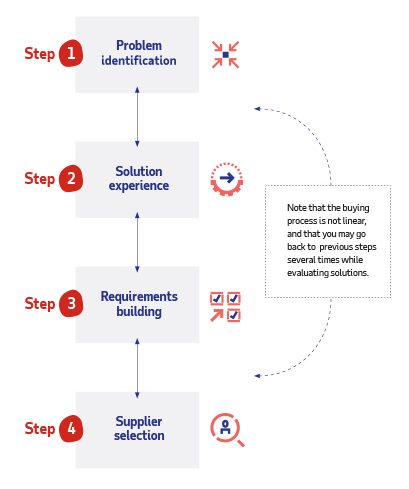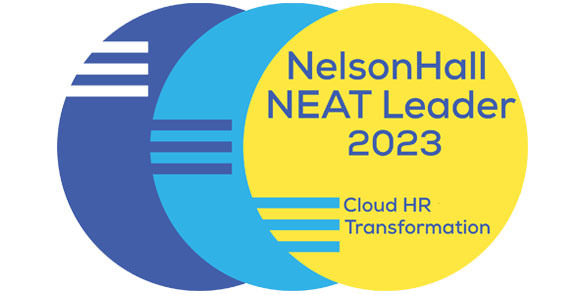Today’s human capital management (HCM) systems are designed to improve employee and manager productivity, meet the core needs of HR, eliminate costly redundancies and synchronize data into a trusted source of decision-making insight. If this sounds like something your business can benefit from, but you’re not sure where to begin, ADP’s HCM Buyer’s Guide can help. We’ll walk you through the process of evaluating HCM solutions and what to look for in a provider.
The HCM buying process
Selecting an HCM solution starts with a thorough analysis of your current business processes and challenges (Step 1 - Problem identification). After you've identified the areas that need improvement and opportunities for growth, you can create a list of requirements for a new system (Steps 2 & 3 – Solution exploration and Requirements building). From there, you can explore different solutions and vendors and compare their suitability for your organization (Step 4 – Supplier selection).

Step 1 – Problem identification: Define the HCM challenges of your current state
To convince senior leaders that a new approach to HCM is needed, you must clearly demonstrate how your existing environment is not only insufficient to drive the organization forward, but also is holding it back. Trying to identify detailed functional requirements – by location, role, user or functional area – will quickly overwhelm your stakeholders. Instead, consolidate your current gaps and functional requirements into high-level challenges, such as:
- Workforce complexity
- Cost of ownership
- Inefficient workflows, technology or reporting processes
- Compliance risk and data security
Step 2 – Solution exploration: Features of best-fit HCM solutions
How do you choose from the HCM solutions available in the marketplace when many of them offer similar capabilities? Some vendors differentiate their offerings with future-forward solutions that can help put you at the forefront of global workforce transformations. When evaluating HCM solutions, consider these areas of opportunity:
- Actionable insights
Fully integrated HCM systems that allow users to derive actionable business insight provide a valuable service that may improve profitability.
- Personalized employee experiences
Some HCM technology is capable of delivering solutions when, where and how employees need them most.
- Globalization
If your organization has a global presence, you may need to choose an HCM solution that offers multinational payroll, local service capabilities and compliance across all of your geographical areas of operation.
Step 3 – Requirements building: HCM features and tools that best support your goals
Once you’ve identified the obstacles that are holding your organization back and the opportunities that you’d like to address, you’re ready to start building your HCM requirements. Here are some of the common challenges faced by enterprise-level organizations and the corresponding HCM features that can help solve them:
Profitability
An integrated HCM solution may allow you to control and reduce direct labor costs and associated administrative expenses. Look for solutions that offer:
- Automation
Automated workflows can help reduce expense by streamlining or even eliminating tasks.
- Complete integration
A fully integrated solution provides a complete hire-to-retire approach that eliminates duplicate data-entry and conflicting data.
- Self-Service
Mobile self-service empowers employees to complete their own tasks, reducing work for managers and practitioners.
- Artificial Intelligence
Some technology can process complex work without human intervention.
- Data accessibility
Secure, role-appropriate access to dashboards may make reporting and analysis more efficient.
Support for business growth
Enterprises seeking to expand geographically or pursue mergers and acquisitions need to manage the increasing complexity of an evolving workforce. An HCM solution that’s capable of supporting planned growth and adjusting to unexpected changes should be:
- Cloud-based
Solutions in the cloud can reduce the burden on your organization’s IT staff and infrastructure.
- Global
If your organization is international, you may need a solution that centralizes your payroll data into a single system of record.
- Supportive of all worker types
Ensure adoption of your new system by choosing one that addresses the unique needs of different departments, work groups, business units and worker types.
- Adaptable
Your solution should be able to incrementally deploy select functional capabilities as needed by pay group, location or division on a single platform and common database.
- Expandable
Look for an HCM provider that offers a marketplace of targeted turnkey solutions built for highly specialized functions that can integrate with your system.
Talent strategy optimization
Organizations relying on the workforce as a competitive advantage may have to attract top talent, enrich the employee and workplace experience, and foster employee development. An HCM solution can help with:
- Talent management
Seek integrated talent management solutions that span acquisition, onboarding, training and professional development, compensation planning and succession.
- Recruitment
Look for a modern recruiting experience that features automated resume scanning, simplified interview scheduling and direct integration to talent pools, like LinkedIn.
- Onboarding
Advanced onboarding capabilities can create an exceptional new hire experience with guided workflows for administrative paperwork, multimedia-based training and even networking with the new team.
- Training
Learning capabilities should offer easy and convenient mobile access and foster social learning among peers.
- Compensation planning
Tools ought to address nearly any compensation plan – like bonuses, commission and equity awards – and offer benchmarking against similar industries and geographies.
- Feedback and coaching
Instead of settling for traditional talent development approaches (9-box, rating/ranking, etc.), seek solutions that offer innovative alternatives.
- Analytics and benchmarking
The most powerful solutions go beyond self-to-self comparisons and provide benchmarks against industry or regional peers in crucial areas, such as overtime, turnover, compensation and pay equity.
- Wellness and benefits
Your HCM solution should effectively administer traditional benefits while offering voluntary benefits to enhance employee engagement and increase productivity.
- Flexible pay options
Offering personalized pay – including early access to wages, pay cards and choice of pay frequency – enhances employee engagement and helps them manage savings and spending.
- Mobile access
Anywhere, anytime access to information can help foster flexible work schedules and work-life balance, making your organization attractive to new and existing talent.
Security and compliance
Organizations seeking to control their exposure to constant risk must eliminate errors and mitigate threats. Security should include technology, privacy and data protection, and disaster response and recovery plans.
Regulatory compliance
HCM systems ought to have the global and/or local monitoring capabilities appropriate for your organization so it can continually update and stay current with changing regulations. You may also value a partner that offers dedicated experts in risk-heavy HR tasks, like wage garnishment and employment tax.
Cloud deployment
A proven and trusted cloud deployment usually has multi-layered protection, including physical security, data security and fraud detection. It should also collaborate with federal and internal law enforcement agencies, such as the FBI, US Secret Service and National Cyber Security Alliance.
HCM support and service
Service models, levels of support and expertise vary among HCM providers, but may include:
- Implementation
An ideal HCM partner may reduce the burden on your IT department and support you throughout the implementation process.
- Data migration
Look to your CIO and IT department to help assess vendors’ proposed plans and identify the important questions you’ll need each one to answer.
- Advisory services
Rely on your provider to study the technology and data landscape and continually monitor workforce trends and regulatory changes.
Step 4 – Supplier selection: Evaluating HCM vendors and solutions
For detailed guidance on validating HCM vendors, please review our HCM buyer’s checklist.
Go deeper


